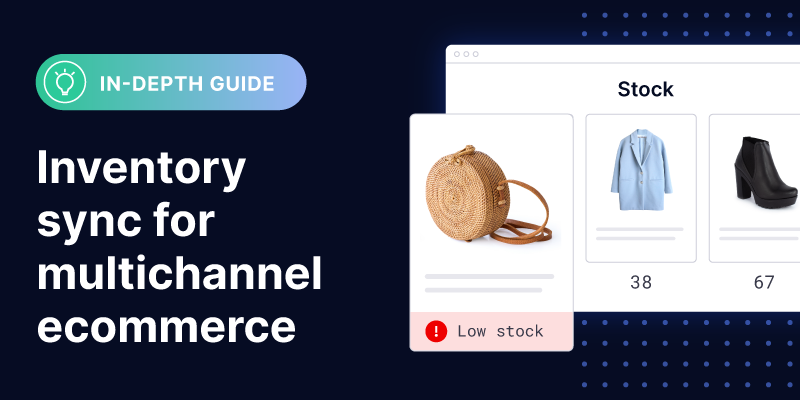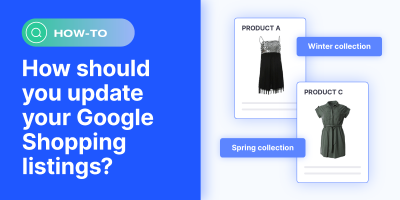Managing inventory across multiple ecommerce channels can quickly become overwhelming. Without accurate, automated inventory synchronization, it’s easy to run into issues like overselling, stockouts, and seller account suspensions—especially when you’re selling on multiple channels like Amazon, Walmart, Google Shopping, and your online store.
That’s where inventory sync comes in. By connecting your systems and enabling automatic inventory updates, you can ensure that your stock levels are always accurate—no matter how many sales channels you’re listing products on. This helps you deliver a better customer experience and allows you to scale your business with confidence and efficiency.
In this article, we’ll break down how inventory sync works, the tools that power it, and why it’s essential for any growing ecommerce brand with multichannel or omnichannel ambitions.
What inventory sync is and why it matters
At its core, inventory sync refers to the automatic updating of inventory data—such as stock levels, SKU counts, and product variants—across all the platforms and systems through which you sell.
Whether you’re managing multiple marketplaces, using third-party logistics providers, or syncing between your ecommerce platform and your ad channels, having consistent, up-to-date inventory across the board is crucial.
Without proper inventory synchronization, your business risks overselling products that are no longer in stock or missing sales opportunities when items are available but incorrectly marked as out of stock. Manual updates can’t keep up with the pace of modern ecommerce, especially if you’re processing hundreds or thousands of orders a day.
That’s why automation plays such a big role in today’s inventory strategy. By enabling automated inventory updates, merchants can avoid costly errors, improve operational efficiency, and make smarter decisions based on accurate inventory counts—not outdated spreadsheets or guesswork.
How inventory sync works for multichannel ecommerce
In a multichannel setup, inventory sync ensures that any change to your stock levels—whether it’s from a sale, return, or restock—is reflected across all your sales channels in real-time, near real-time, or via regularly scheduled feed updates. The speed and accuracy of your inventory sync will depend on how you’ve set it or what your solution provider is capable of.
Most modern ecommerce systems use APIs to exchange data between platforms.
For example, let’s say you want to synchronize your in-store inventory with your ecommerce platform. As long as your point of sale (POS) system has an API, it can be integrated with an ecommerce platform that also has an open API architecture, like BigCommerce.
API connections also enable you to update inventory in real-time or near real-time. For example, Event-Driven Real-Time Sync uses events—such as pricing and inventory changes—to trigger automatic data updates between your source of record and hundreds of the top advertising channels and marketplaces.
Some businesses also schedule inventory updates using CSV or XML files. While not in real-time, these batch processes can still help maintain consistency across platforms. These can be ingested and sent via FTP connections from your ERP, PIM, or ecommerce platform.
Use cases for ecommerce inventory sync
Having the right inventory sync solution in place isn’t just a convenience—it’s a safeguard against the costly risks of having outdated inventory included in your product listings. Here are common scenarios where inventory sync is mission-critical:
Selling on marketplaces
If you’re selling on marketplaces like Amazon, Walmart, eBay, or SHEIN, you’ll want a single sale on one platform to adjust stock levels across all others. Failing to sync accurately can lead to overselling, negative reviews, and even account suspensions—especially when marketplaces monitor order defect rates (ODR) closely. According to a Feedonomics study, more than 50% of all Google account suspension and product disapproval warnings stem from price or availability errors.
Selling on ad channels
When advertising products on channels like Google Shopping, Meta, or Microsoft Ads, accurate inventory sync is just as critical as it is on marketplaces. These platforms rely on your product feed to reflect accurate inventory availability—if an item is out of stock but still listed as available in your ad, it can result in product disapprovals or account suspensions.
Google’s Local Inventory Ads (LIAs) add another layer of complexity. These ads show nearby shoppers which products are in stock at your physical store locations. To run them effectively, you need accurate inventory data at the store level, updated frequently. Inventory mismatches damage trust and reduce the effectiveness of your ad spend.
Managing multiple warehouses or store locations
For sellers with a distributed fulfillment network, syncing inventory across retail locations, warehouses, 3PLs, and fulfillment services like Amazon Multi-Channel Fulfillment ensures accurate inventory counts.
Solutions that can integrate with multiple inventory sources—while accounting for latency and restock times with inventory buffers—are key to maintaining accuracy across all selling and advertising channels.
High-volume sales and limited-edition drops
During flash sales, seasonal spikes, or limited-edition product launches, real-time sync helps prevent overselling and ensures product availability reflects reality. This is essential for brands with small-batch SKUs or boutiques offering one-of-a-kind items.
Meeting real-time data requirements of partners
Some marketplaces and instant commerce platforms (like local delivery apps) require real-time synchronization to integrate your product feeds. If your system can’t sync quickly enough, your listings may be rejected—or worse, your business might lose opportunities to more agile competitors.
Using a feed management platform to sync product data across your channels
Inventory sync is a foundational element of efficient, scalable multichannel operations—but a powerful feed management platform like Feedonomics does much more than just keep stock levels up to date.
Feedonomics gives you complete control over your product data, from syncing inventory and pricing to optimizing listings and ensuring channel compliance. This all-in-one approach helps ecommerce businesses maintain accurate, high-quality product data across every connected marketplace, ad channel, and ecommerce platform.
Out-of-the-box integrations with hundreds of marketplaces and ad channels
Feedonomics supports hundreds of marketplaces, ad channels, and ecommerce platforms—from Amazon, Walmart, and eBay to Google, Meta, TikTok, and many more.
These out-of-the-box connections allow you to:
- Quickly onboard new sales or ad channels
- Push real-time or scheduled inventory and pricing updates across platforms
- Stay compliant with each channel’s unique data requirements and formatting rules
Optimize your product data for every channel
Syncing inventory is just one part of the equation—your product data also needs to be optimized to meet the unique requirements and best practices of each channel. Feedonomics not only automates data sync but also enhances your product listings for better visibility and performance.
With Feedonomics, you can:
- Clean and normalize product titles, descriptions, and attributes
- Map and transform data to match channel-specific requirements
- Customize listings per channel to improve relevance and engagement
Optimized product data ensures your listings are more likely to be approved, surface in search results, and convert shoppers—whether you’re selling on Amazon, running Local Inventory Ads on Google, or promoting products on Meta.
Streamline order management across marketplaces
Syncing inventory is just one part of the equation—orders must be accurately tracked and fulfilled across your connected systems, too. Manual order management is not only time-consuming but also prone to errors that can lead to delays, overselling, and unhappy customers.
With Feedonomics, you can:
- Import orders from each marketplace into your ecommerce platform or order management system (OMS)
- Push fulfillment data from your OMS to marketplaces like Amazon, eBay, and Walmart
- Automatically update inventory levels and stock reductions as orders are placed and fulfilled
- Translate and map order data formats between platforms to ensure seamless communication
- Route and split orders using custom rules to determine which fulfillment method—your warehouse, OMS, or a solution like Amazon MCF—handles each order
Scale with confidence
By centralizing your product data and automating sync across systems, Feedonomics helps you unlock operational efficiency, avoid costly mistakes, and deliver a better experience for both your customers and your team.
With Feedonomics, you don’t have to build or maintain custom integrations yourself. Instead, you can rely on a platform designed to handle the complexity of multichannel selling—helping you scale efficiently, reduce time to market, and stay focused on strategy and growth with a team of feed specialists to back you up.
Feedonomics enables you to synchronize your product data with hundreds of marketplaces and ad channels
Inventory sync for multichannel ecommerce FAQs
What is inventory sync and why is it important for ecommerce businesses?
Inventory sync ensures that your product availability and stock levels are automatically updated across all connected platforms. For multichannel sellers, this prevents overselling, improves inventory management, and keeps the customer experience consistent across every sales channel.
How does inventory sync help streamline operations for multichannel ecommerce sellers?
Automated inventory sync helps streamline your operations by reducing manual tasks and minimizing errors. When inventory levels are updated in real time across all channels, your team spends less time on data entry and more time on growth. This is especially useful for sellers managing large catalogs, multiple warehouses, or working with fulfillment partners like ShipStation or Amazon MCF.
How often should inventory sync across platforms?
Ideally, inventory synchronization should happen in real time or near real time. This is especially important for high-volume sellers or businesses using multiple sales channels, where stock changes rapidly and delays could result in customer service issues or lost revenue.
Some businesses don’t necessarily need inventory to be synced that often, in which case a solution that sends out inventory updates on a regularly scheduled basis several times per day may be more appropriate.
Can I enable inventory sync on ecommerce platforms like Shopify?
Yes! Popular ecommerce platforms like WooCommerce, Wix, BigCommerce, and Shopify support inventory syncing through built-in features, third-party apps, or integrations with feed management platforms.
For example, Shopify stores can sync inventory across multiple sales channels using native tools or solutions like Feedonomics. With the right setup, your Shopify inventory—including product variants and quantities—can stay automatically updated across marketplaces like Amazon and eBay, as well as with your POS system. Enabling stock sync ensures accurate availability, reduces the risk of overselling, and helps streamline your multichannel operations.
What happens if I don’t use inventory sync?
Without an automated sync solution, you’ll need to manually update your inventory data across platforms. This increases your risk of stock errors, creates inefficiencies in your workflows, and opens the door to overselling, mispricing, and customer dissatisfaction.

Muhammed is a content marketing specialist creating informative content to help ecommerce professionals solve industry challenges and stay ahead of the curve.




